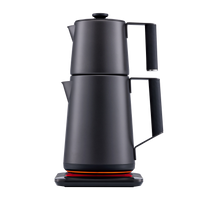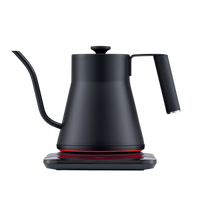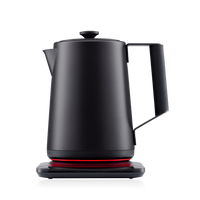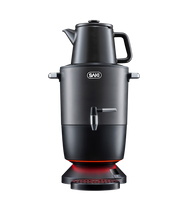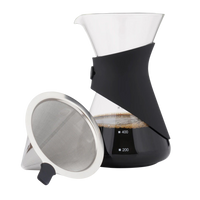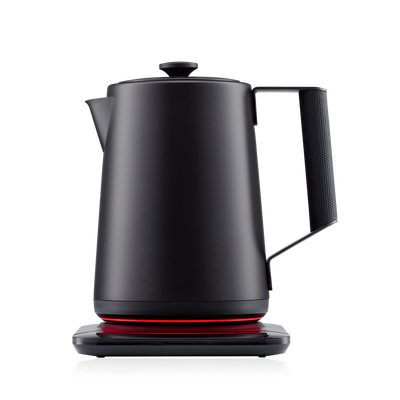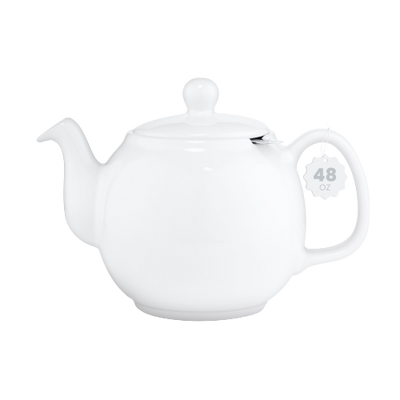how to make perfect white tea at home: a step-by-step guide
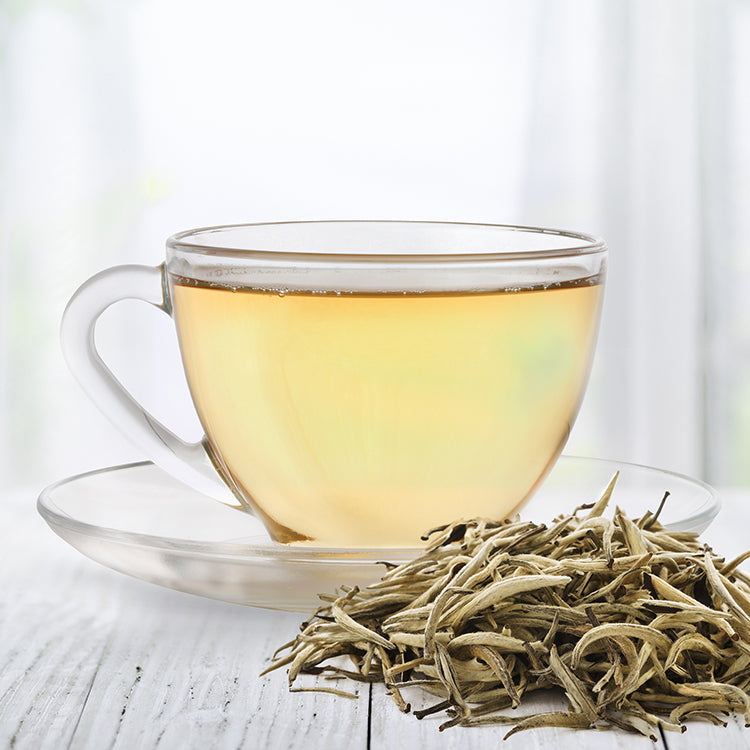
Summary: Indulge in the elegance of white tea, a world of subtle flavors. Joining this journey are your trusty Porcelain Teapot and the Luna Electric Tea Kettle. Together, they orchestrate perfection. Discover the secrets of this timeless art and let the soothing embrace of white tea elevate your moments, one sip at a time.
Calling all tea enthusiasts! If you have a penchant for the subtle and delightful flavors of white tea, prepare to be enchanted. In this blog, we embark on a journey into the world of white tea, and we've got the perfect companions for the ride: the exquisite Porcelain Teapot and the innovative Luna Electric Tea Kettle. Whether you're a novice or a seasoned enthusiast, we'll help you brew the perfect cup.
Why Drink White Tea?
White tea, the jewel of the tea world, is renowned for its gentle, natural sweetness and a plethora of health benefits. It's the least processed among all the varieties of tea made from the Camellia sinensis plant, preserving a bounty of antioxidants and polyphenols. What's more, it's famously low in caffeine, making it the perfect choice for those tranquil moments any time of day.
What is White Tea?
Derived from young buds and fresh tea leaves of the Camellia sinensis plant, white tea is a masterpiece of minimalism in tea-making. It undergoes a swift drying process, either basking in the gentle sun's rays or in carefully designated indoor or outdoor spaces. It's these young, tender leaves that give white tea its name, thanks to the fine white hairs that adorn them, resulting in a pale yellow infusion.
As for the caffeine content, white tea takes the prize for being the least caffeinated among its tea cousins: black, yellow and green tea. However, don't be fooled by its mild nature; it's packed with antioxidants like polyphenols, flavonoids, and tannins—akin to its green tea counterpart.
How to Drink White Tea?
White tea isn't limited to a soothing hot cup; it's also the star of refreshing iced teas and the secret ingredient in a variety of tantalizing cocktails, from rum concoctions to vodka delights. Just a word of caution: not all drinks labeled "white tea" actually contain this precious brew.
So…
And what's the secret to unlocking the full potential of white tea's subtle charm? It begins with the artful brewing that only a porcelain teapot and a temperature-adjusted kettle can deliver. Together, they'll elevate your tea experience, infusing every cup with warmth and elegance.
So, whether you're seeking serenity in a cup or aiming to explore the world of white tea's delicate delights, our dynamic duo of tea tools will be your trusted companions on this aromatic journey. Embrace the soothing allure of white tea today and let the SAKI Large Porcelain Teapot and Luna Electric Tea Kettle be your guide to a world of warmth and wellness!
What You'll Need:
- White tea leaves (about 1 teaspoon per cup)
- Fresh, cold water
- A porcelain teapot
- Luna Electric Tea Kettle
- A cup or tea mug
- A timer
What You’ll Do:
Preparation: Start by choosing your favorite white tea leaves. Silver Needle (Bai Hao Yin Zhen), White Peony (Bai Mu Dan) and Long Life Eyebrow (Shou Mei) are popular choices. Measure about 1 teaspoon of tea leaves per cup.
Boiling Water: Fill the electric tea kettle with fresh, cold water. White tea is delicate, so it's important not to use boiling water. Instead, set the Luna Electric Tea Kettle to heat the water to around 160°F (71°C).
Warming the Teapot: While the water is heating, warm your teapot by rinsing it with hot water and then pouring it out. This helps maintain the tea's temperature when brewing.
Tea Leaves in the Teapot: Place your measured tea leaves into the warmed teapot.
Pouring the Water: Once the tea kettle reaches the ideal temperature, carefully pour the hot water over the tea leaves in the teapot. Ensure the leaves are fully submerged.
Steeping Time: Set a timer for about 3-5 minutes. The steeping time can vary depending on your personal preference and the specific white tea you're using. Less time will result in a lighter flavor, while more time will make it stronger. Experiment to find your perfect steeping time.
Pour and Enjoy: When the timer goes off, pour the brewed white tea into your cup or tea mug. Be sure to use a strainer to catch any loose tea leaves if your teapot doesn't have an integrated infuser, which SAKI Large Porcelain Teapot has.
Tips for a Perfect White Tea Brew:
- Use fresh, high-quality white tea leaves for the best flavor.
- Don't rush the heating process. Using water that's too hot can result in a bitter taste.
- Experiment with different steeping times to find your preferred strength.
- Feel free to add honey or a slice of lemon for extra flavor.
Conclusion
Brewing white tea with a porcelain teapot and an electric tea kettle is a delightful ritual that brings out the exquisite flavors of this delicate tea. Whether you're sipping it to relax or to savor the health benefits, using the right tools and following the steps outlined in this guide will ensure a satisfying and enjoyable tea experience. So, grab your SAKI Large Porcelain Teapot and the Luna Electric Tea Kettle, and start brewing your perfect cup of white tea today!
Common Questions & Answers
Q: What is white tea, and how is it different from other types of tea?
A: White tea is one of the six main types of tea derived from the Camellia sinensis plant, known for its delicate flavor. What sets white tea apart is its minimal processing. It's made from young tea buds and fresh leaves, which are dried without oxidation, preserving their natural purity. Unlike green tea, white tea is not heat-treated after plucking, resulting in a lighter flavor profile.
Q: Does white tea contain caffeine?
A: Yes, white tea contains caffeine, but it generally has less caffeine compared to other tea varieties like black or green tea. The caffeine content can vary depending on factors like the type of white tea and how it's brewed. However, it's still a good choice if you're looking for a tea with a milder caffeine kick.
Q: What are the health benefits of white tea?
A: White tea is rich in antioxidants, including polyphenols, flavonoids, and tannins, similar to green tea. These antioxidants are believed to have various health benefits, such as supporting heart health, boosting the immune system, and promoting skin health. White tea is also known for its low caffeine content, making it a soothing choice for relaxation.
Q: How should I brew white tea for the best flavor?
A: To brew the best cup of white tea, use fresh, high-quality tea leaves. Water should be heated to around 160°F (71°C) – not boiling – and poured over the tea leaves in a pre-warmed teapot. Steeping time can vary but typically ranges from 3 to 5 minutes. Adjust the steeping time to achieve your preferred strength. Finally, strain the tea before serving to avoid loose leaves in your cup.
Q: How should I serve white tea?
A: White tea is traditionally served in a porcelain teacup with a saucer. Since it has a very light taste, it is not common to add sweeteners into it. Still, you can offer some honey, maple syrup, or sugar along with it as well as a light snack and a piece of lemon.
Q: Can I enjoy white tea as iced tea?
A: Absolutely! White tea can be enjoyed both warm and iced. To make iced white tea, follow the brewing instructions to create a concentrated infusion. Then, simply refrigerate the brewed tea until it's chilled to your liking. You can add ice, a slice of lemon, or even a touch of sweetener if you prefer. Iced white tea offers a refreshing option for hot summer days or as a unique twist on traditional white tea.
Q: Should I use loose tea leaves or tea bags to make white tea?
A: It is always better to use loose tea leaves to make tea since the flavor of the bag will also infuse into the water and spoil the taste of the final infusion.
Q: Does white tea help bowel movement?
A: As a stimulating warm drink, white tea helps encourage bowel movement for many people.
